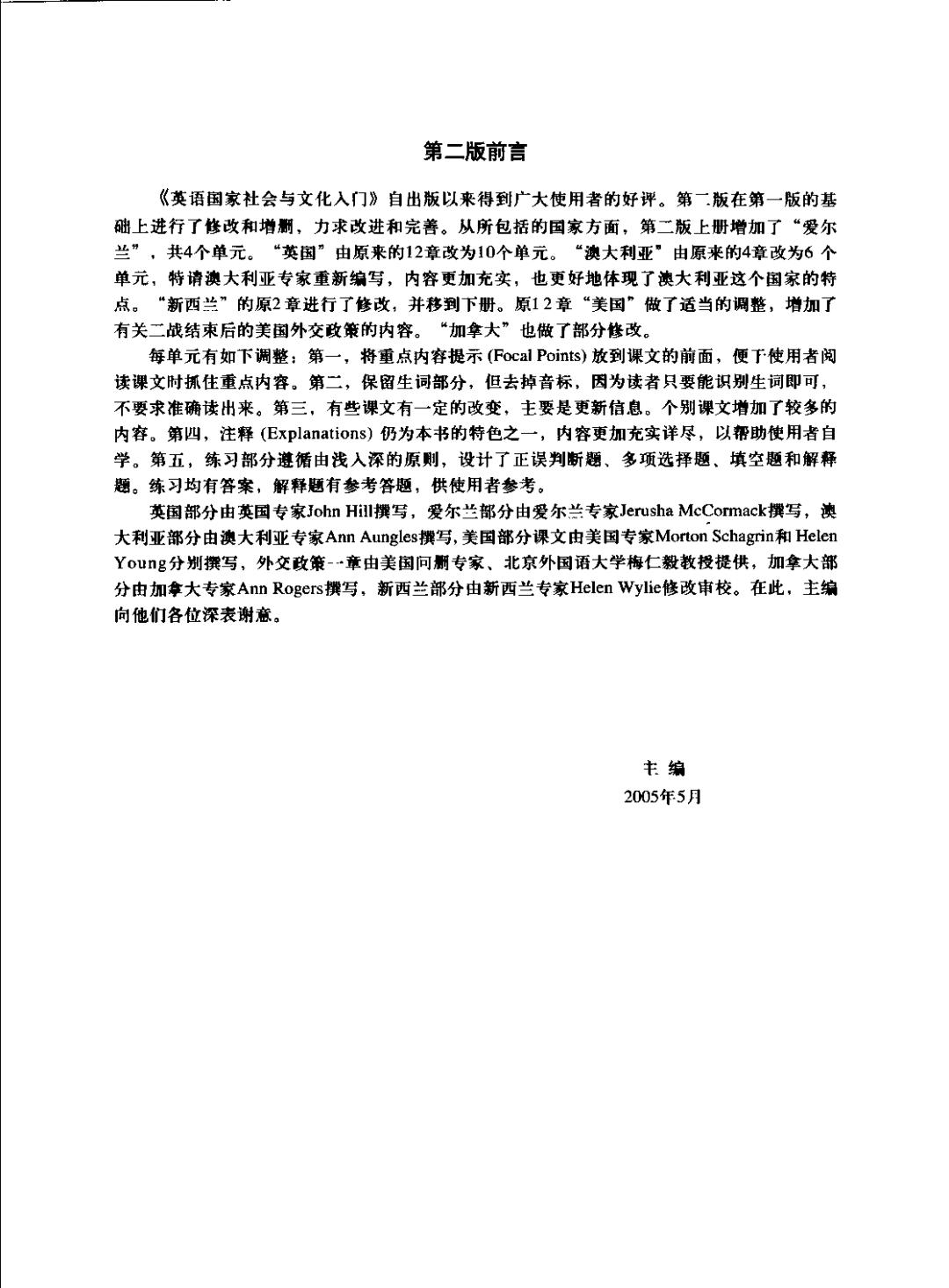
第二版前言 《英语国家社会与文化入门》自出版以来得到广大使用者的好评。第一版在第一版的基 础上进行了修改和增翻,力求改进和完善。从所包括的国家方面,第二版上册增加了“爱尔 兰”,共4个单元。“英国”由原来的12章改为10个单元。“澳大利亚”由原来的4章改为6个 单元,特请澳大利亚专家重新编写,内容更加充实,也更好地体现了澳大利亚这个国家的特 点。“新西兰”的原2章进行了修改,并移到下册。原12章“美国”做了适当的调整,增加了 有关二战结束后的美国外交改策的内容。“加拿大”也做了部分镂改。 每单元有如下调整:第一,将重点内容提示(Focal Points)放到课文的前面,便于使用者阅 读课文时抓住重点内容。第二,保留生词部分,但去掉音标,因为读者只要能识别生词即可, 不要求准确读州来。第三,有些课文有一定的改变,主要是更新信息。个别课文增加了较多的 内容。第四,注释(Explanations)仍为本书的特色之一,内容更加充实详尽,以帮助使用者自 学。第五,练习部分遵循由浅入深的原则,设计了正误判断题、多项选择题、填空题和解释 题。练习均有答案,解释题有参考答题,供使用者参考。 英国部分由英国专家John Hill撰写,爱尔兰部分由爱尔兰专家Jerusha McCormack撰写,澳 大利亚部分由澳大利亚专家Ann Aungles撰写,美国部分课文由美国专家Morton Schagrin和Helen Yo心ng分别撰写,外交改策-一章由美国问删专家、北京外国语大学梅仁毅教授提供,加拿大部 分由加拿大专家Ann Rogers撰写,新西兰部分由新西兰专家Helen Wylie修改审校。在此,主编 向他们各位深表谢意。 丰编 2005年5月
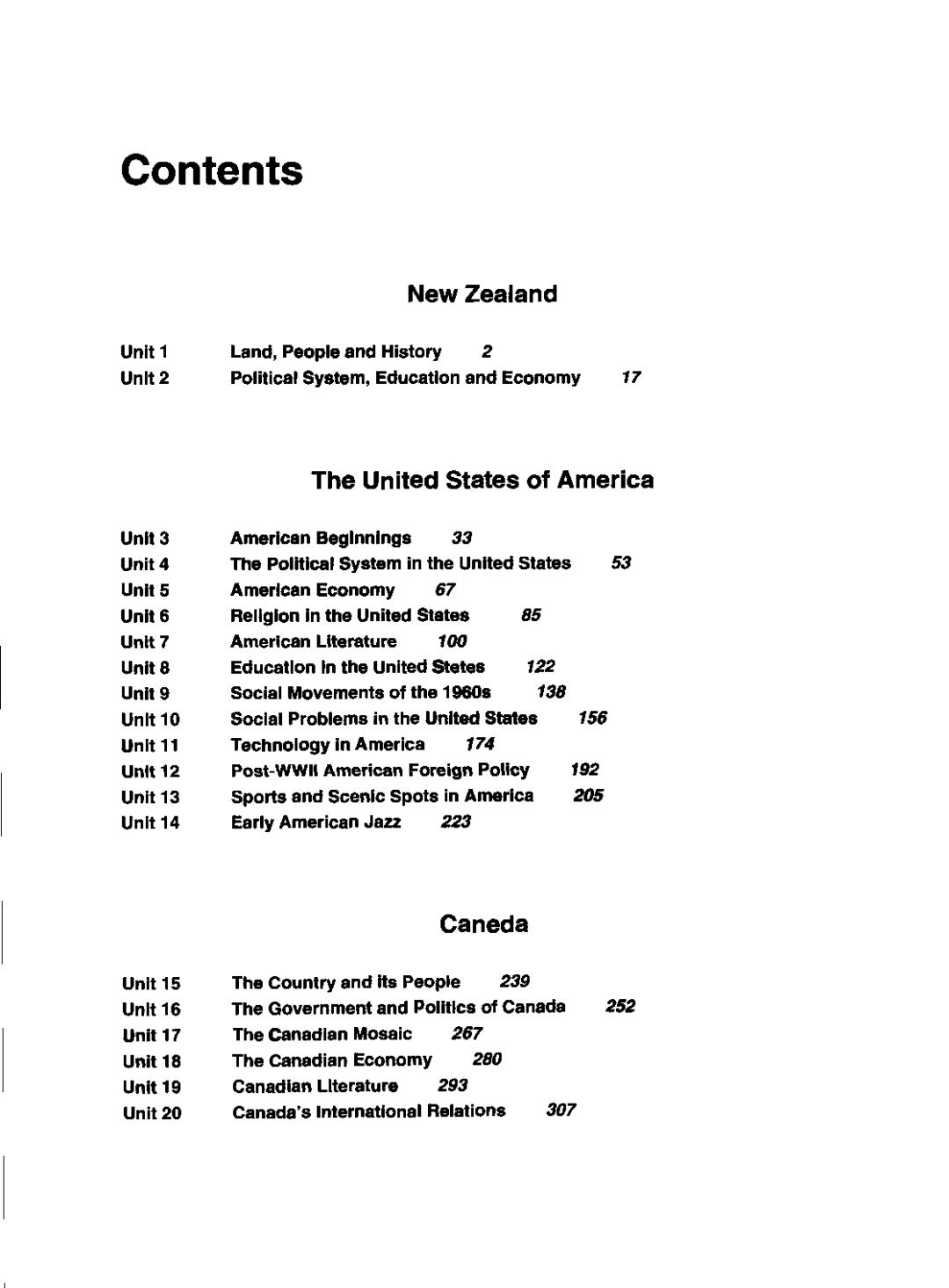
Contents New Zealand Unit 1 Land, People and History 2 Unlt 2 Political System, Education and Economy 17 The United States of America Unit 3 American Beglnnings 33 Unit 4 The Political System in the United States 53 Unit 5 Amerlcan Economy 67 Unit 6 Religion in the United States 85 Unit 7 American Literature 100 Unit 8 Educatlon in the United Stetes 122 Unit 9 Social Movements of the 1960s 138 Unlt 10 Social Problems in the United States 156 Unit 11 Technology in America 174 Unit 12 Post-WWll American Foreign Policy 192 Unit 13 Sports and Scenic Spots in America 205 Unit 14 Early American Jazz 223 Caneda Unit 15 The Country and its People 239 Unlt 16 The Government and Politlcs of Canada 252 Unit 17 The Canadian Mosaic 267 Unit 18 The Canadian Economy 280 Unit 19 Canadian Llterature 293 Unit 20 Canada's International Relations 307

Unit 1 LAND,PEOPLE AND HISTORY Go over the following focal points before reading the text: geography:Narth Island and South Island weather wildlifeunique flora and fauna environmental responsibility Maori society Maoritanga Pacific Island people race relations history:first settlers of the Islands relationship between Maori and Pakeha Text New Zealand is a special country in many ways.It is a small coun- geological adj. try with a small population,a long way from the large powerful coun- 地质学的 tries,but many people know about New Zealand. Maybe when someone mentions New Zealand you think of a clean, green image:fresh air;clean rivers,lakes and sea;clean food;green trees and mountains and blue skies.Some people are aware of New Zealand because it has an interesting geological history.The islands of New Zealand have been separated from other land for millions of years, and they have unique plants,birds and insects. Some people know about New Zealand because the Government and people speak out against nuclear weapons and nuclear power.Some people may know that in 1893 New Zealand became the first country in
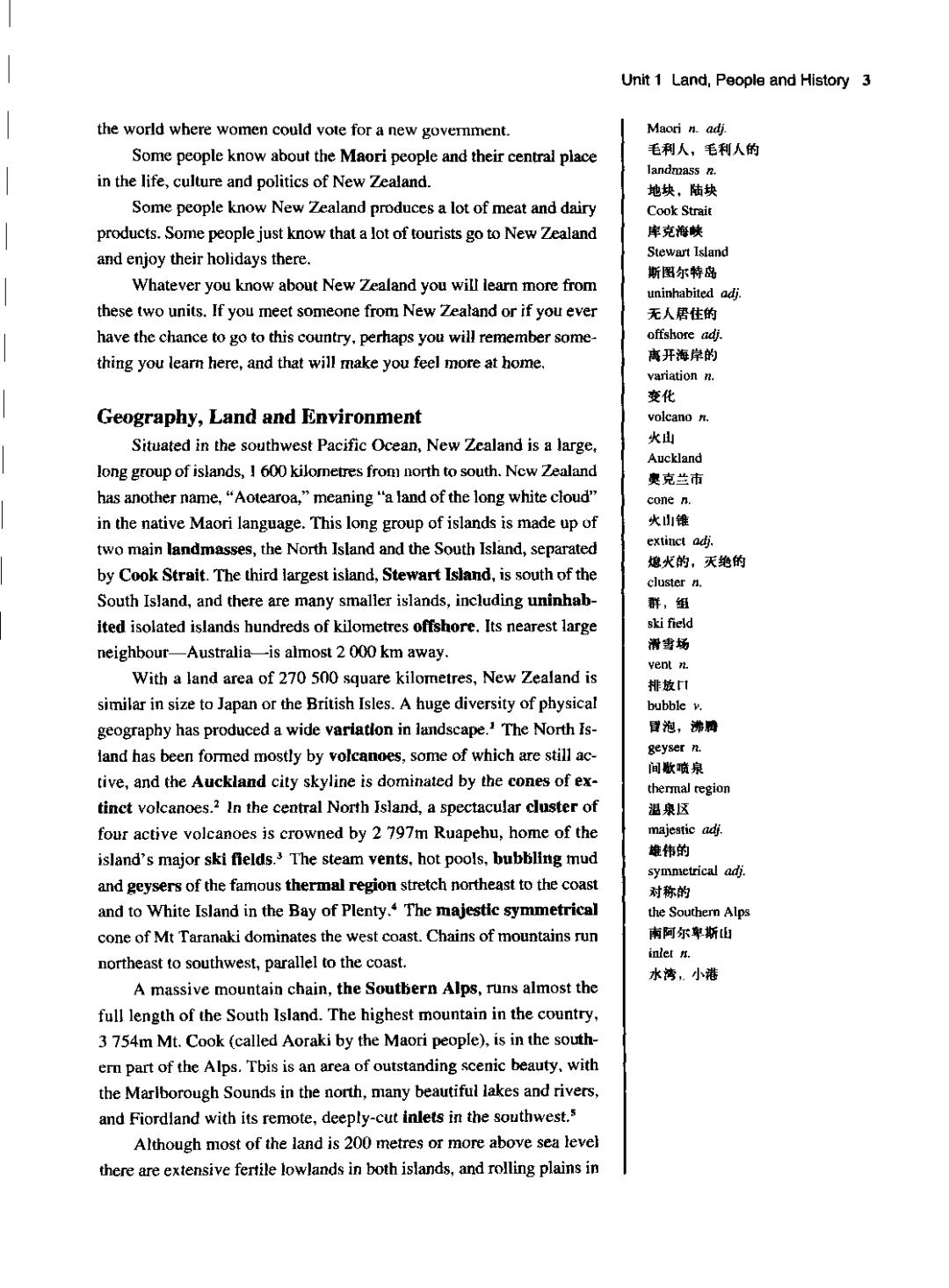
Unit 1 Land,People and History 3 the world where women could vote for a new goverment. Maori n.adj. Some people know about the Maori people and their central place 毛利人,毛利人的 landmass n. in the life,culture and politics of New Zealand. 地块,陆块 Some people know New Zealand produces a lot of meat and dairy Cook Strait products.Some people just know that a lot of tourists go to New Zealand 库克海峡 and enjoy their holidays there. Stewart Island 斯图尔特岛 Whatever you know about New Zealand you will learn more from uninhabited adj. these two units.If you meet someone from New Zealand or if you ever 无人居住的 have the chance to go to this country,perhaps you will remember some- offshore adj thing you learn here,and that will make you feel more at home. 离开海岸的 variation n. 变化 Geography,Land and Environment volcano n. Situated in the southwest Pacific Ocean,New Zealand is a large, 火山 Auckland long group of islands,600 kilometres from north to south.Ncw Zealand 臭克兰市 has another name,"Aotearoa,"meaning"a land of the long white cloud" cone n. in the native Maori language.This long group of islands is made up of 火山锥 two main landmasses,the North Island and the South Island,separated extinct adi. 熄火的,灭绝的 by Cook Strait.The third largest island,Stewart Island,is south of the cluster n. South Island,and there are many smaller islands,including uninhab- 群,组 ited isolated islands hundreds of kilometres offshore.Its nearest large ski field neighbour-Australia-is almost 2 000 km away. 滑雪场 yent n. With a land area of 270 500 square kilometres,New Zealand is 排放F口 similar in size to Japan or the British Isles.A huge diversity of physical bubble v. geography has produced a wide variatlon in landscape.1 The North Is- 置泡,沸烟 land has been formed mostly by volcanoes,some of which are still ac- geyser n. 间歇喷泉 tive,and the Auckland city skyline is dominated by the cones of ex- thermal region tinet volcanoes.2 In the central North Island,a spectacular cluster of 温泉区 four active volcanoes is crowned by 2 797m Ruapehu,home of the majestic adj. island's major ski fields.3 The steam vents,hot pools,bubbling mud 雄伟的 symmetrical adj. and geysers of the famous thermal region stretch northeast to the coast 对称的 and to White Island in the Bay of Plenty.The majestic symmetrical the Southern Alps cone of Mt Taranaki dominates the west coast.Chains of mountains run 南阿尔单斯山 northeast to southwest,parallel to the coast. iniet 水湾,小港 A massive mountain chain,the Southern Alps,runs almost the full length of the South Island.The highest mountain in the country, 3 754m Mt.Cook (called Aoraki by the Maori people),is in the south- ern part of the Alps.Tbis is an area of outstanding scenic beauty,with the Marlborough Sounds in the north,many beautiful lakes and rivers, and Fiordland with its remote,deeply-cut inlets in the southwest.s Although most of the land is 200 metres or more above sea level there are extensive fertile lowlands in both islands,and rolling plains in
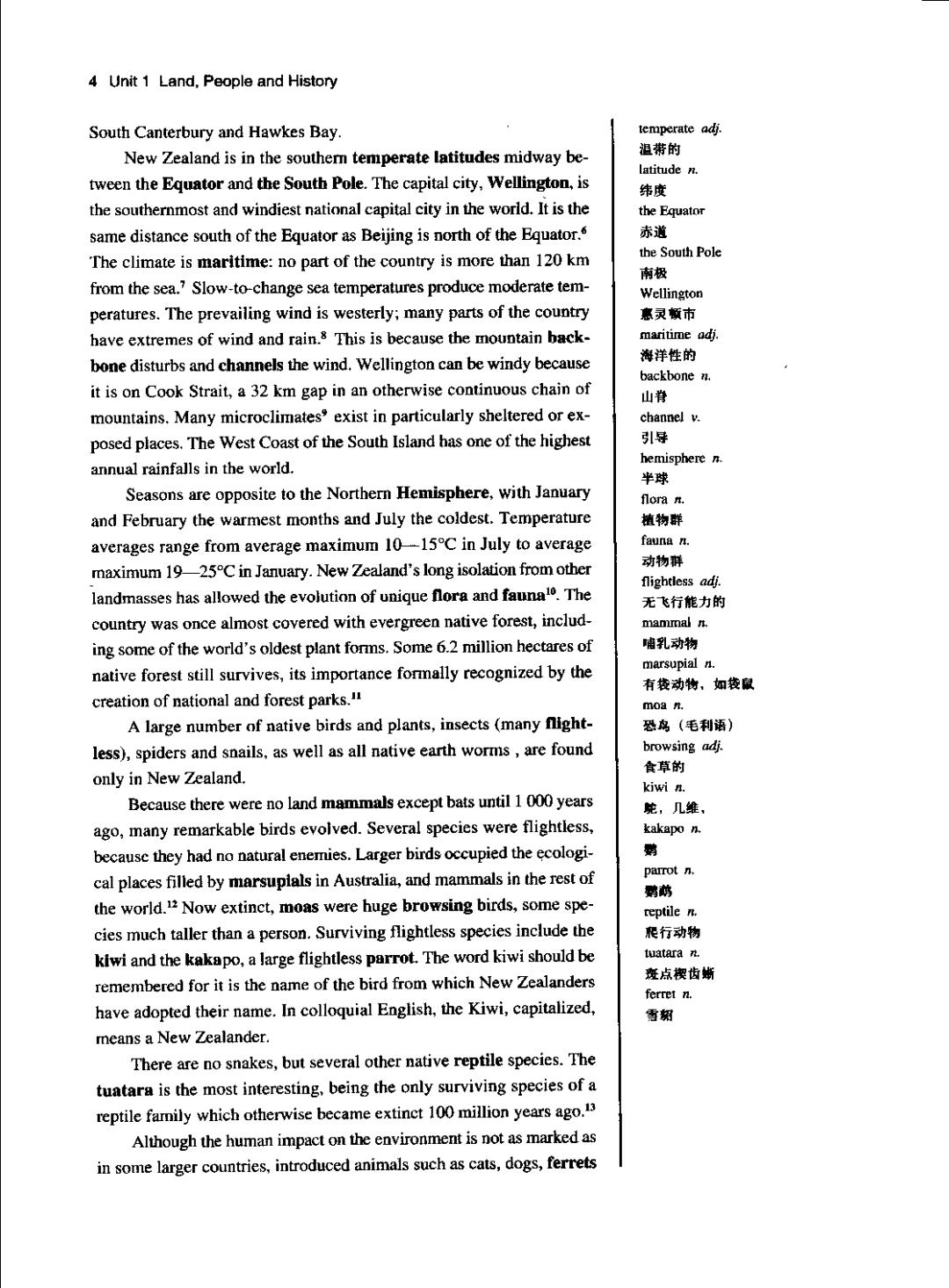
4 Unit 1 Land,People and History South Canterbury and Hawkes Bay. temperate adj. New Zealand is in the souther temperate latitudes midway be- 温带的 latitude n. tween the Equator and the South Pole.The capital city,Wellington,is 纬度 the southernmost and windiest national capital city in the world.It is the the Equator same distance south of the Equator as Beijing is north of the Equator.s 赤道 The climate is maritime:no part of the country is more than 120 km the South Pole 南极 from the sea.?Slow-to-change sea temperatures produce moderate tem- Wellington peratures.The prevailing wind is westerly;many parts of the country 惠灵顺市 have extremes of wind and rain.8 This is because the mountain back- maritime adj. 海洋性的 bone disturbs and channels the wind.Wellington can be windy because backbone n. it is on Cook Strait,a 32 km gap in an otherwise continuous chain of 山脊 mountains.Many microclimates exist in particularly sheltered or ex- channel v. posed places.The West Coast of the South Island has one of the highest 引导 annual rainfalls in the world. hemisphere n 半球 Seasons are opposite to the Northern Hemisphere,with January flora n. and February the warmest months and July the coldest.Temperature 植物群 averages range from average maximum 10-15C in July to average fauna n. maximum 19-25C in January.New Zealand's long isolation from other 动物群 flightless adj. landmasses has allowed the evolution of unique flora and faunal.The 无飞行能力的 country was once almost covered with evergreen native forest,includ- mammal n. ing some of the world's oldest plant forms.Some 6.2 million hectares of 哺乳动物 native forest still survives,its importance formally recognized by the marsupial n. 有袋动物、如袋酿 creation of national and forest parks. moa n. A large number of native birds and plants,insects(many flight- 恐鸟(毛利语) less),spiders and snails,as well as all native earth worms,are found browsing adj. 食草的 only in New Zealand. kiwi n. Because there were no land mammals except bats until 1 000 years 蛇,几维, ago,many remarkable birds evolved.Several species were flightless, kakapo n. because they had no natural enemies.Larger birds occupied the ecologi- 鹦 cal places filled by marsupials in Australia,and mammals in the rest of parrot n. 剪鹉 the world.12 Now extinct,moas were huge browsing birds,some spe- reptile n. cies much taller than a person.Surviving flightless species include the 爬行动物 kiwi and the kakapo,a large flightless parrot.The word kiwi should be tuatara n. remembered for it is the name of the bird from which New Zealanders 斑点楔齿蜥 ferret n. have adopted their name.In colloquial English,the Kiwi,capitalized, 雪期 means a New Zealander. There are no snakes,but several other native reptile species.The tuatara is the most interesting,being the only surviving species of a reptile family which otherwise became extinct 100 million years ago.1 Although the human impact on the environment is not as marked as in some larger countries,introduced animals such as cats,dogs,ferrets
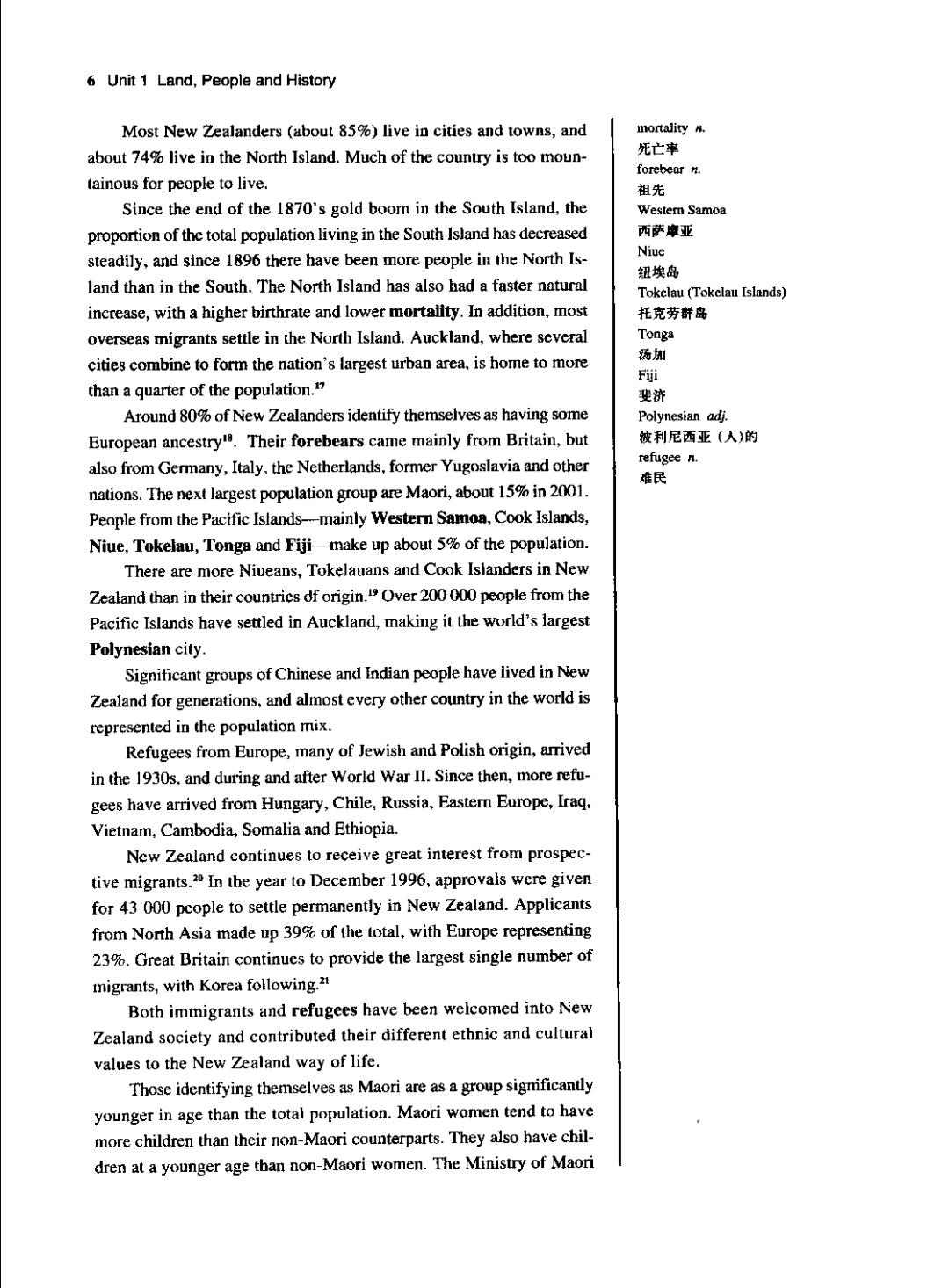
6 Unit 1 Land,People and History Most New Zealanders (about 85%)live in cities and towns,and mortality M. about 74%live in the North Island.Much of the country is too moun- 死亡率 forebear n. tainous for people to live. 祖先 Since the end of the 1870's gold boom in the South Island,the Western Samoa proportion of the total population living in the South Island has decreased 西萨卓亚 steadily,and since 1896 there have been more people in the North Is- Niue 纽埃岛 land than in the South.The North Island has also had a faster natural Tokelau (Tokelau Islands) increase,with a higher birthrate and lower mortality.In addition,most 托克劳群岛 overseas migrants settle in the North Island.Auckland,where several Tonga cities combine to form the nation's largest urban area,is home to more 汤加 Fii than a quarter of the population. 斐济 Around 80%of New Zealanders identify themselves as having some Polynesian adj European ancestry1.Their forebears came mainly from Britain,but 被利尼西亚〔人)的 also from Germany,Italy,the Netherlands,former Yugoslavia and other refugee n. 难民 nations.The next largest population group are Maori,about 15%in 2001. People from the Pacific Islands-mainly Western Samoa,Cook Islands, Niue,Tokelau,Tonga and Fiji-make up about 5%of the population. There are more Niueans,Tokelauans and Cook Islanders in New Zealand than in their countries df origin.Over 200 000 people from the Pacific Islands have settled in Auckland,making it the world's largest Polynesian city. Significant groups of Chinese and Indian people have lived in New Zealand for generations,and almost every other country in the world is represented in the population mix. Refugees from Europe,many of Jewish and Polish origin,arrived in the 1930s,and during and after World War II.Since then,more refu- gees have arrived from Hungary,Chile,Russia,Eastern Europe,Iraq, Vietnam,Cambodia,Somalia and Ethiopia. New Zealand continues to receive great interest from prospec- tive migrants.20 In the year to December 1996,approvals were given for 43 000 people to settle permanently in New Zealand.Applicants from North Asia made up 39%of the total,with Europe representing 23%.Great Britain continues to provide the largest single number of migrants,with Korea following.2t Both immigrants and refugees have been welcomed into New Zealand society and contributed their different ethnic and cultural values to the New Zealand way of life. Those identifying themselves as Maori are as a group sigmificantly younger in age than the total population.Maori women tend to have more children than their non-Maori counterparts.They also have chil- dren at a younger age than non-Maori women.The Ministry of Maori
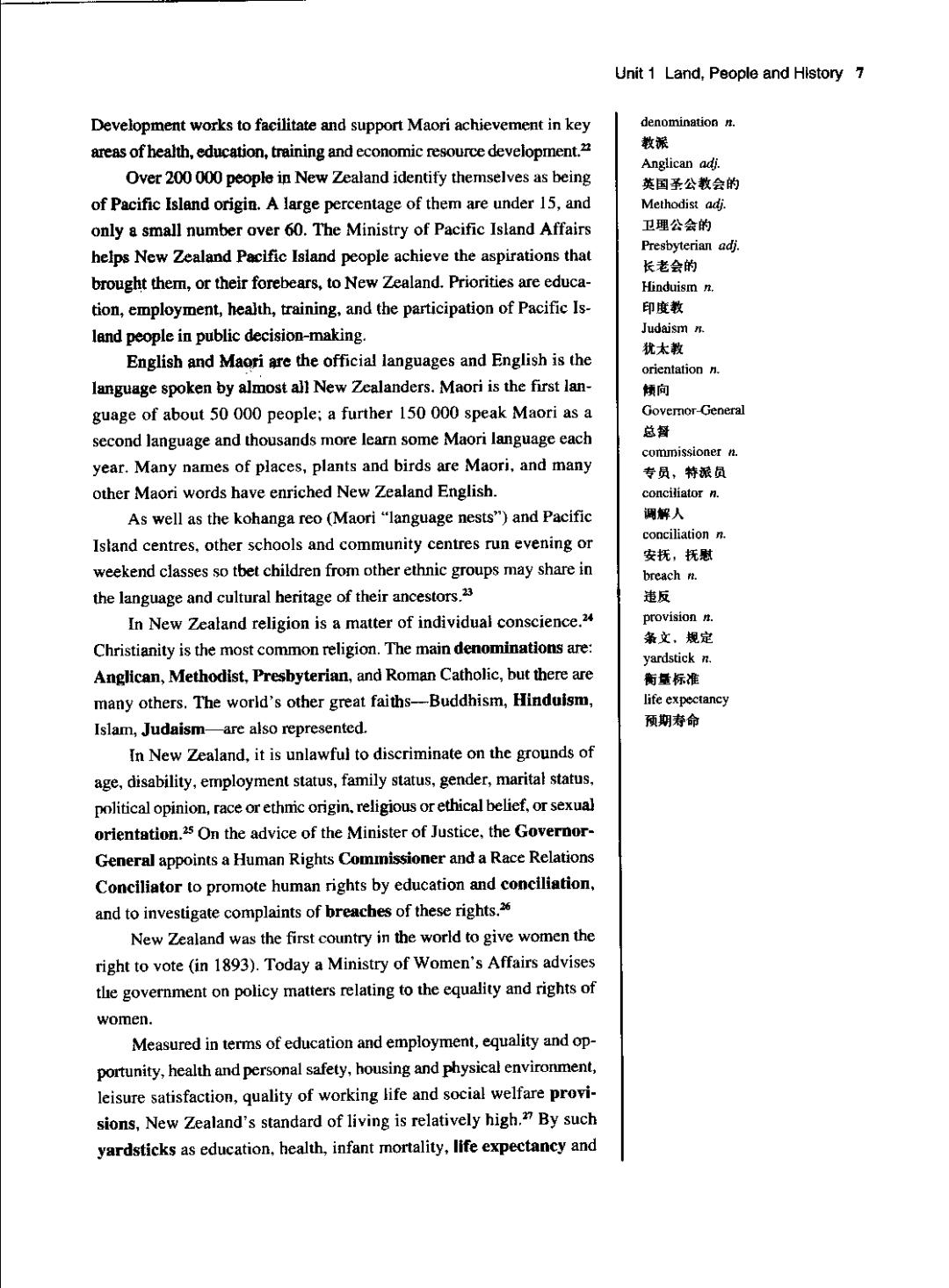
Unit 1 Land,People and History 7 Development works to facilitate and support Maori achievement in key denomination n. areas of health,education,training and economic resource development.22 教派 Anglican adi. Over 200 000 people in New Zealand identify themselves as being 英国圣公教会的 of Pacific Island origin.A large percentage of them are under 15,and Methodist adj. only a small number over 60.The Ministry of Pacific Island Affairs 卫理公会的 helps New Zealand Pacific Island people achieve the aspirations that Presbyterian adj. 长老会的 brought them,or their forebears,to New Zealand.Priorities are educa- Hinduism n. tion,employment,health,training,and the participation of Pacific Is- 印度教 land people in public decision-making. Judaism n. 犹太教 English and Maori are the official languages and English is the orientation n. language spoken by almost all New Zealanders.Maori is the first lan- 顿向 guage of about 50 000 people;a further 150 000 speak Maori as a Goveror-General second language and thousands more learn some Maori language each 总母 commissioner n. year.Many names of places,plants and birds are Maori,and many 专员,特派员 other Maori words have enriched New Zealand English. conciliator n. As well as the kohanga reo (Maori "language nests")and Pacific 调解人 conciliation n. Island centres,other schools and community centres run evening or 安抚,抚慰 weekend classes so tbet children from other ethnic groups may share in breach n. the language and cultural heritage of their ancestors.23 违反 In New Zealand religion is a matter of individual conscience.24 provision n. 条文,规定 Christianity is the most common religion.The main denominations are: yardstick n. Anglican,Methodist,Presbyterian,and Roman Catholic,but there are 衡量标准 many others.The world's other great faiths-Buddhism,Hinduism, life expectancy Islam,Judaism-are also represented. 预期寿命 In New Zealand,it is unlawful to discriminate on the grounds of age,disability,employment status,family status,gender,marital status, political opinion,race or ethmic origin.religious or ethical belief,or sexual orientation.25 On the advice of the Minister of Justice,the Governor- General appoints a Human Rights Commissioner and a Race Relations Conciliator to promote human rights by education and conciliation, and to investigate complaints of breaches of these rights.2 New Zealand was the first country in the world to give women the right to vote (in 1893).Today a Ministry of Women's Affairs advises the government on policy matters relating to the equality and rights of women. Measured in terms of education and employment,equality and op- portunity,health and personal safety,housing and physical environment, leisure satisfaction,quality of working life and social welfare provi- sions,New Zealand's standard of living is relatively high,27 By such yardsticks as education.health,infant mortality,life expectancy and
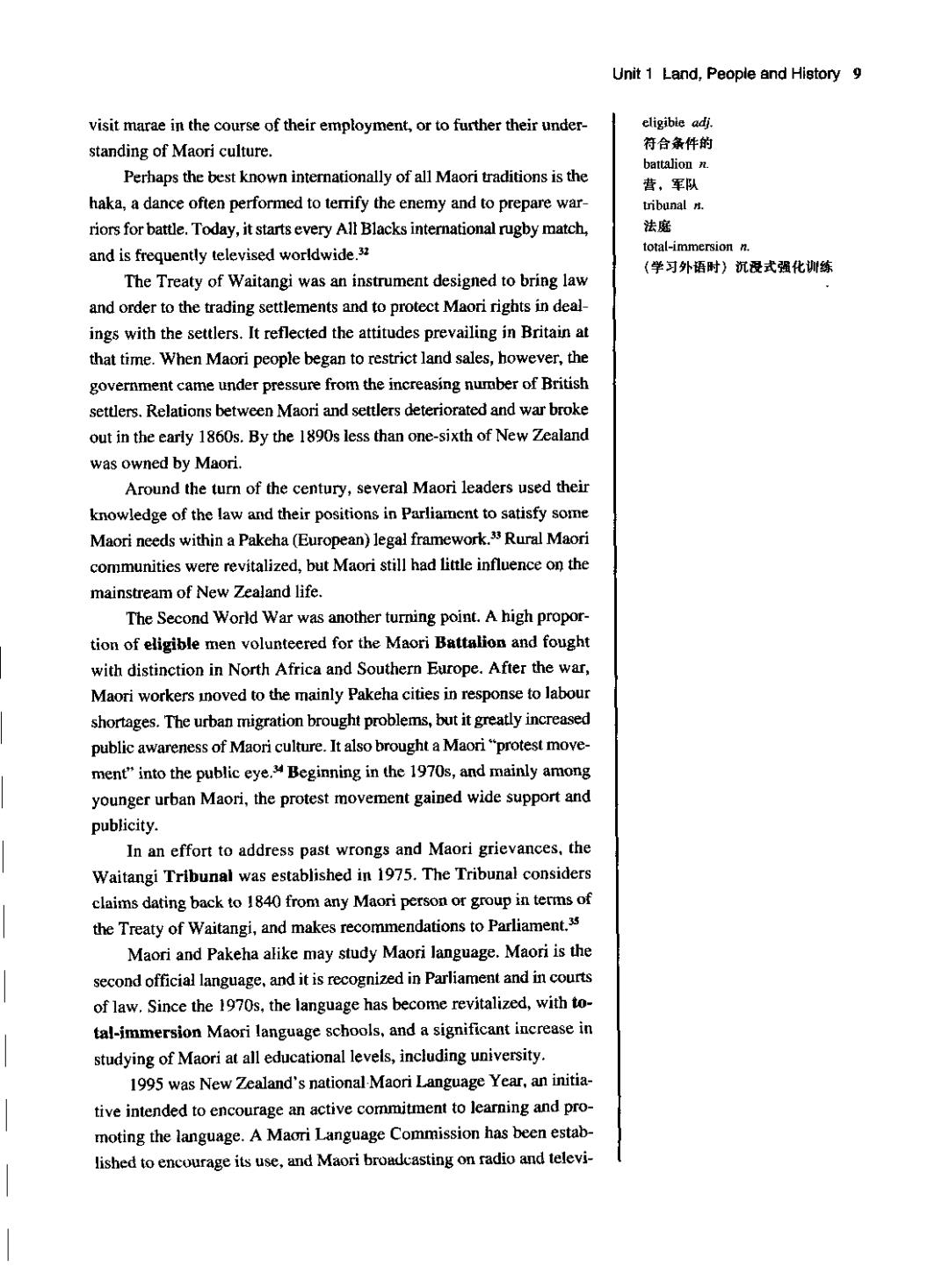
Unit 1 Land,People and History 9 visit marae in the course of their employment,or to further their under- eligible adj. standing of Maori culture. 符合条件的 battalion n. Perhaps the best known internationally of all Maori traditions is the 营,军队 haka,a dance often performed to terrify the enemy and to prepare war- tribunal n. riors for battle.Today,it starts every All Blacks international rugby match, 法庭 and is frequently televised worldwide.3 total-immersion n. (学习外语时)沉没式强化训练 The Treaty of Waitangi was an instrument designed to bring law and order to the trading settlements and to protect Maori rights in deal- ings with the settlers.It reflected the attitudes prevailing in Britain at that time.When Maori people began to restrict land sales,however,the government came under pressure from the increasing number of British settlers.Relations between Maori and settlers deteriorated and war broke out in the early 1860s.By the 1890s less than one-sixth of New Zealand was owned by Maori. Around the turn of the century,several Maori leaders used their knowledge of the law and their positions in Parliament to satisfy some Maori needs within a Pakeha(European)legal framework.3 Rural Maori communities were revitalized,but Maori still had little influence on the mainstream of New Zealand life. The Second World War was another turning point.A high propor- tion of eligible men volunteered for the Maori Battalion and fought with distinction in North Africa and Southern Europe.After the war, Maori workers inoved to the mainly Pakeha cities in response to labour shortages.The urban migration brought problems,but it greatly increased public awareness of Maori culture.It also brought a Maori"protest move- ment"into the public eye."Beginning in the 1970s,and mainly among younger urban Maori,the protest movement gained wide support and publicity. In an effort to address past wrongs and Maori grievances,the Waitangi Tribunal was established in 1975.The Tribunal considers claims dating back to 1840 from any Maori person or group in terms of the Treaty of Waitangi,and makes recommendations to Parliament.35 Maori and Pakeha alike may study Maori language.Maori is the second official language,and it is recognized in Parliament and in courts of law.Since the 1970s,the language has become revitalized,with to- tal-immersion Maori language schools,and a significant increase in studying of Maori at all educational levels,including university. 1995 was New Zealand's national Maori Language Year,an initia- tive intended to encourage an active commitment to learning and pro- moting the language.A Maori Language Commission has been estab- lished to encourage its use,and Maori broadcasting on radio and televi-
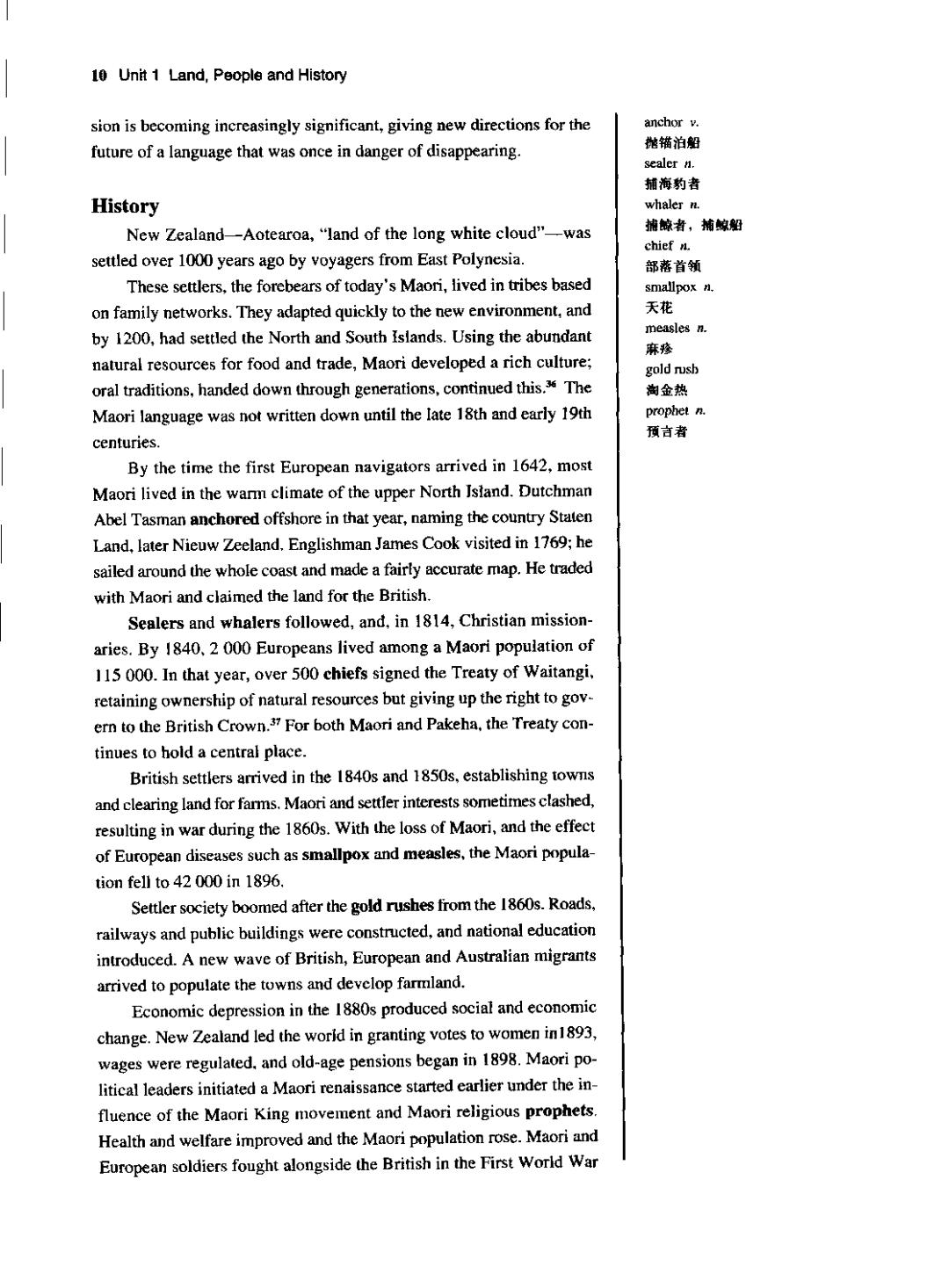
10 Unit 1 Land,People and History sion is becoming increasingly significant,giving new directions for the anchor v. future of a language that was once in danger of disappearing. 抛锚泊船 sealer n. 捕海豹者 History whaler n. New Zealand-Aotearoa,"land of the long white cloud"-was 捕脉者,辅鲸船 chief n. settled over 1000 years ago by voyagers from East Polynesia. 部落首领 These settlers,the forebears of today's Maori,lived in tribes based smallpox n. on family networks.They adapted quickly to the new environment,and 天花 by 1200,had settled the North and South Islands.Using the abundant measles n. 麻疹 natural resources for food and trade,Maori developed a rich culture; gold rush oral traditions,handed down through generations,continued this.The 淘金热 Maori language was not written down until the late 18th and early 19th prophet n. 预言者 centuries. By the time the first European navigators arrived in 1642,most Maori lived in the warm climate of the upper North Istand.Dutchman Abel Tasman anchored offshore in that year,naming the country Staten Land,later Nieuw Zeeland.Englishman James Cook visited in 1769;he sailed around the whole coast and made a fairly accurate map.He traded with Maori and claimed the land for the British. Sealers and whalers followed,and,in 1814,Christian mission- aries.By 1840,2 000 Europeans lived among a Maori population of 115 000.In that year,over 500 chiefs signed the Treaty of Waitangi, retaining ownership of natural resources but giving up the right to gov- ern to the British Crown.37 For both Maori and Pakeha,the Treaty con- tinues to hold a central place. British settlers arrived in the 1840s and 1850s,establishing towns and clearing land for farms.Maori and settler interests sometimes clashed, resulting in war during the 1860s.With the loss of Maori,and the effect of European diseases such as smallpox and measles,the Maori popula- tion fell to 42 000 in 1896. Settler society boomed after the gold rushes from the 1860s.Roads, railways and public buildings were constructed,and national education introduced.A new wave of British,European and Australian migrants arrived to populate the towns and develop farmland. Economic depression in the 1880s produced social and economic change.New Zealand led the worid in granting votes to women in1893, wages were regulated,and old-age pensions began in 1898.Maori po- litical leaders initiated a Maori renaissance started earlier under the in- fluence of the Maori King movement and Maori religious prophets. Health and welfare improved and the Maori population rose.Maori and European soldiers fought alongside the British in the First World War
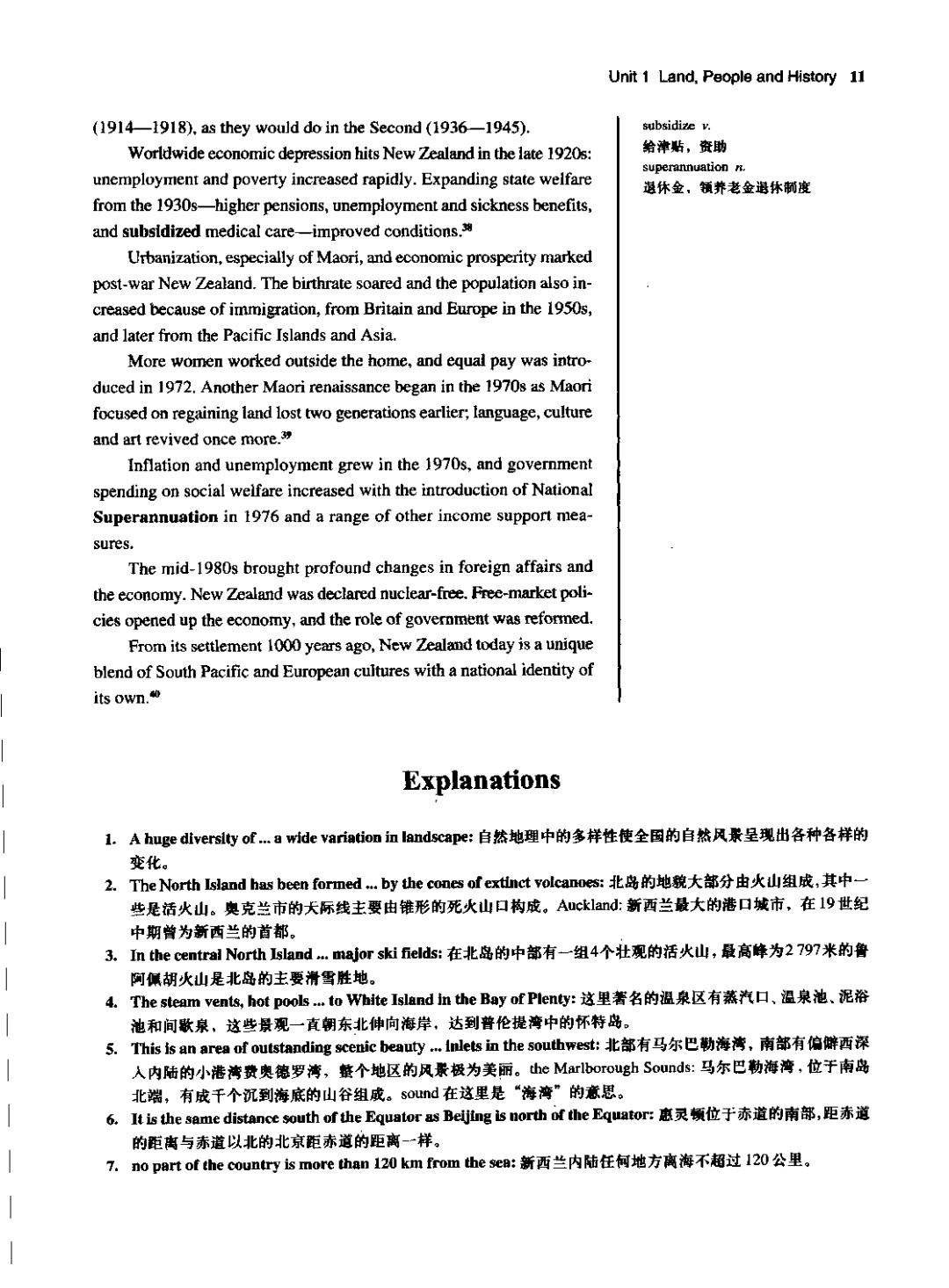
Unit 1 Land,People and History 11 (1914-1918),as they would do in the Second (1936-1945). subsidize v. Worldwide economic depression hits New Zealand in the late 1920s: 给津贴,资助 superannuation r. unemployment and poverty increased rapidly.Expanding state welfare 退休金,领养老金退休制度 from the 1930s-higher pensions,unemployment and sickness benefits, and subsidized medical care-improved conditions.3 Urbanization,especially of Maori,and economic prosperity marked post-war New Zealand.The birthrate soared and the population also in- creased because of immigration,from Britain and Europe in the 1950s, and later from the Pacific Islands and Asia. More women worked outside the home,and equal pay was intro- duced in 1972.Another Maori renaissance began in the 1970s as Maori focused on regaining land lost two generations earlier;language,culture and art revived once more.3 Inflation and unemployment grew in the 1970s,and government spending on social welfare increased with the introduction of National Superannuation in 1976 and a range of other income support mea- sures. The mid-1980s brought profound changes in foreign affairs and the economy.New Zealand was declared nuclear-free.Free-market poli- cies opened up the economy,and the role of government was reformed. From its settlement 1000 years ago,New Zealand today is a unique blend of South Pacific and European cultures with a national identity of its own.0 Explanations l.A huge diverslty of...a wide variation in landscape:自然地理中的多样柱使全国的自然风聚呈现出各种各样的 变化。 2.The North Island has been formed,by the cones of extinct volcanoes:北岛的地貌大部分由火山组成,其中一 些是活火山。奥克兰市的天际线主要由锥形的死火山口构成。Auckland:新西兰最大的港口城市,在I9世纪 中期曾为新西兰的首都。 3.n the central North Island.major ski fields:在北岛的中部有一组4个壮观的活火山,最高降为2797米的鲁 阿佩胡火山是北岛的主要滑雪胜地。 4.The steam vents,.hot pools...to White Island in the Bay of Plenty:这里著名的温泉区有蒸汽口、温泉池、泥浴 池和间歌泉,这些景现一直朝东北伸向海岸,达到普伦提湾中的怀特岛。 5.This is an area of outstanding scenic beauty,inlets in the southwest:北部有马尔巴勒海湾,南部有偏解西深 人内陆的小港湾费奥德罗湾,整个地区的风聚极为美丽。the Marlborough Sounds:马尔巴勒海湾,位于南岛 北端,有成千个沉到海底的山谷组成。sound在这里是“海湾”的意思。 6.It is the same distance south of the Equator as Beijing is north of the Equator::惠灵领位于赤道的南部,距赤道 的距离与赤道以北的北京距赤道的距离-一样。 7.o part of the country is more than120 km from the sea::新西兰内陆任何地方离海不超过120公里